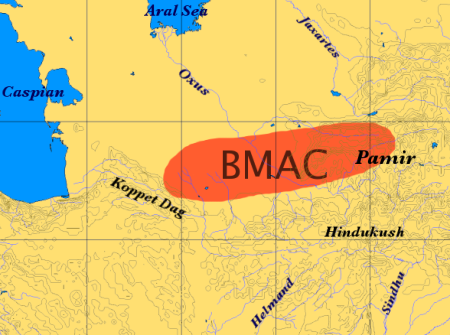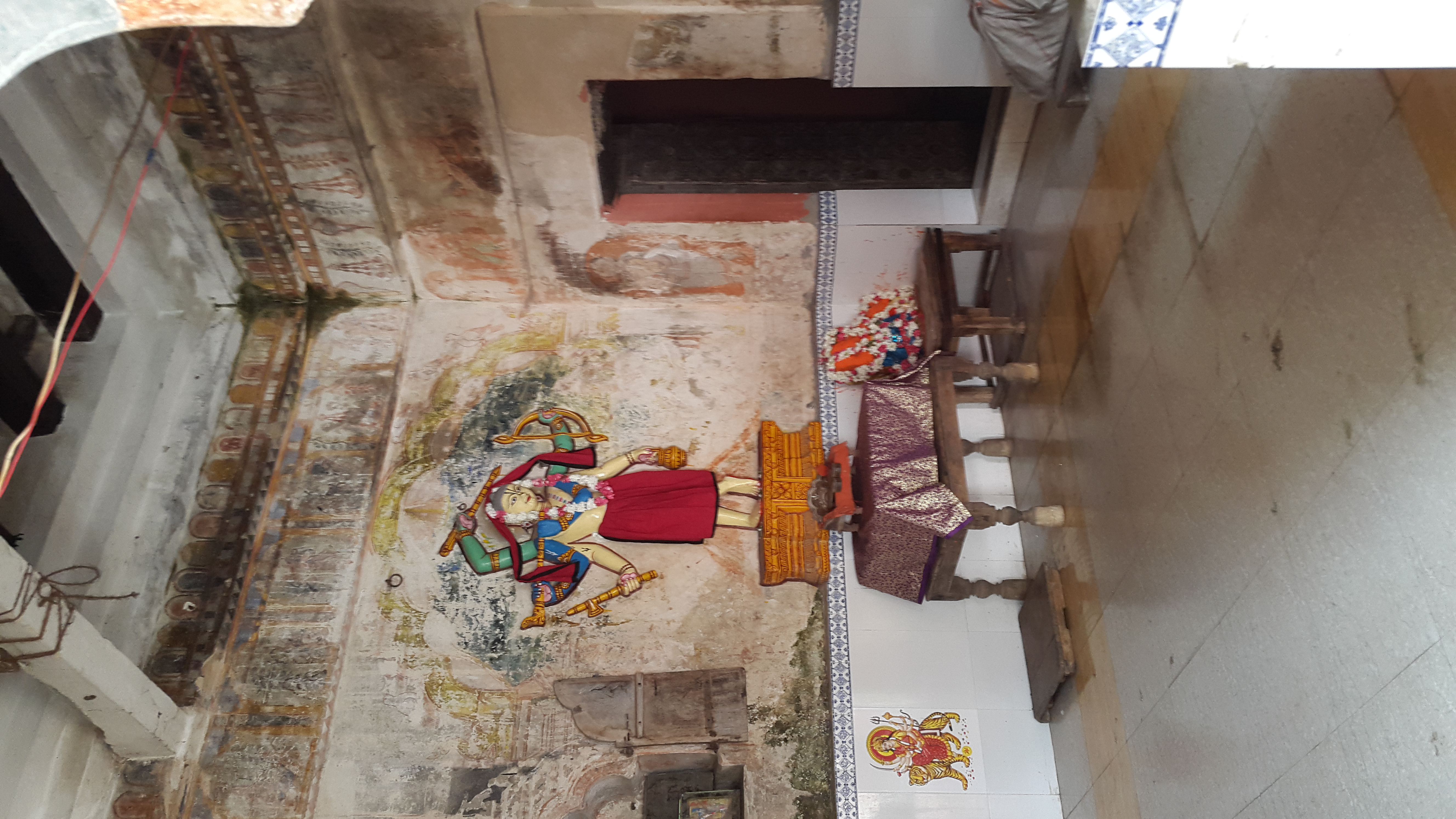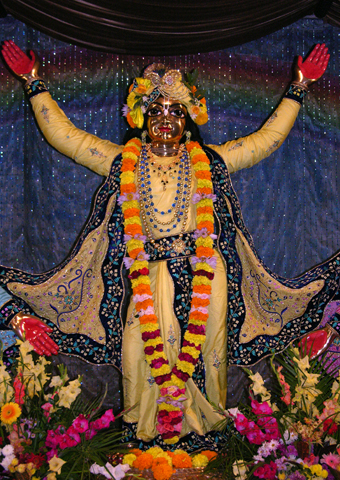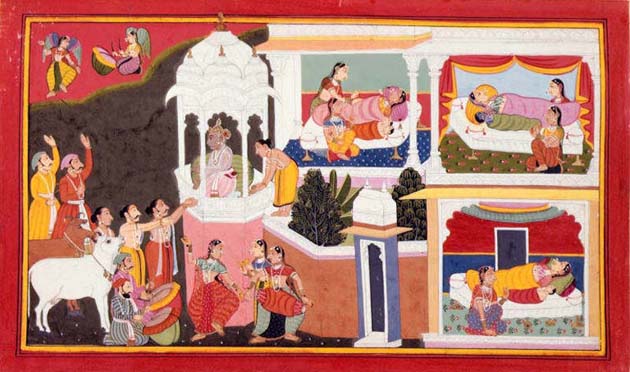|
Kāla
Kala ( sa, काल, lit=Time, translit=Kālá/Kālam), ) is a Sanskrit term that means "time" or "death." As time personified, destroying all things, Kala is a god of death, and often used as one of the epithets of Yama. In Shaivism, Kala is known as the fiery avatar of Shiva Kala Bhairava or Kalagni Rudra; and in Vaishnavism Kala is also associated with Narasimha and Pralaya. As applied to gods and goddesses, ' is not always distinguishable from ', meaning "black." Etymology Monier-Williams's widely used Sanskrit-English dictionary lists two distinct words with the form ': * ' 1 means "black, of a dark colour, dark-blue ..." and has a feminine form ending in ' – ' – as mentioned in 4–1, 42. * ' 2 means "a fixed or right point of time, a space of time, time ... destiny, fate ... death" and has a feminine form (found at the end of compounds) ending in ', as mentioned in the ' '. As a traditional Hindu unit of time, one ''kālá'' corresponds to 144 seconds. Accor ... [...More Info...] [...Related Items...] OR: [Wikipedia] [Google] [Baidu] |
Narasimha
Narasimha ( sa, नरसिंह, lit=man-lion, ), sometimes rendered Narasingha, is the fourth avatar of the Hindu god Vishnu. He is regarded to have incarnated in the form of a part-lion, part-man being to slay Hiranyakashipu, to end religious persecution and calamity on earth, thereby restoring dharma. Narasimha is often depicted with three eyes, and is described in Vaishnavism to be the God of Destruction; he who destroys the entire universe at the time of the great dissolution (Mahapralaya). Hence, he is known as Kala (time) or Mahakala (great-time), or Parakala (beyond time) in his epithets. There exists a matha (monastery) dedicated to him by the name of Parakala Matha in the Sri Vaishnava tradition. Narasimha is also described as the God of Yoga, in the form of Yoga-Narasimha. Narasimha iconography shows him with a human torso and lower body, with a leonine face and claws, typically with the asura Hiranyakashipu in his lap, whom he is in the process of defeat ... [...More Info...] [...Related Items...] OR: [Wikipedia] [Google] [Baidu] |
Yadu
This is a list of ancient Indo-Aryan peoples and tribes that are mentioned in the literature of Indic religions. From the second or first millennium BCE, ancient Indo-Aryan peoples and tribes turned into most of the population in the northern part of the Indian subcontinent – Indus Valley (roughly today's Punjab), Western India, Northern India, Central India, and also in areas of the southern part like Sri Lanka and the Maldives through and after a complex process of migration, assimilation of other peoples and language shift.Mallory, J.P.; Douglas Q. Adams (1997). Encyclopedia of Indo-European Culture. London: Fitzroy Dearborn Publishers. . Ancestors *Proto-Indo-Europeans (Proto-Indo-European speakers) **Proto-Indo-Iranians (common ancestors of the Iranian, Nuristani and Indo-Aryan peoples) (Proto-Indo-Iranian speakers) ***Proto-Indo-Aryans (Proto-Indo-Aryan speakers) Vedic tribes * Alina people (RV 7.18.7) * Andhras * Anu (RV 1.108.8, RV 8.10.5) * Āyu * Bhajeratha * ... [...More Info...] [...Related Items...] OR: [Wikipedia] [Google] [Baidu] |
Krishna
Krishna (; sa, कृष्ण ) is a major deity in Hinduism. He is worshipped as the eighth avatar of Vishnu and also as the Supreme god in his own right. He is the god of protection, compassion, tenderness, and love; and is one of the most popular and widely revered among Indian divinities. Krishna's birthday is celebrated every year by Hindus on Krishna Janmashtami according to the lunisolar Hindu calendar, which falls in late August or early September of the Gregorian calendar. The anecdotes and narratives of Krishna's life are generally titled as ''Krishna Leela''. He is a central character in the ''Mahabharata'', the '' Bhagavata Purana'', the '' Brahma Vaivarta Purana,'' and the '' Bhagavad Gita'', and is mentioned in many Hindu philosophical, theological, and mythological texts. They portray him in various perspectives: as a god-child, a prankster, a model lover, a divine hero, and the universal supreme being. Quote: "Krsna's various appearances as ... [...More Info...] [...Related Items...] OR: [Wikipedia] [Google] [Baidu] |
Chaitanya Mahaprabhu
Chaitanya Mahaprabhu (; born Vishvambhar Mishra) was a 15th-century Indian saint who is considered to be the combined avatar of Radha and Krishna by his disciples and various scriptures. Chaitanya Mahaprabhu's mode of worshipping Krishna with ecstatic song and dance had a profound effect on Vaishnavism in Bengal. He was also the chief proponent of the Vedantic philosophy of Achintya Bheda Abheda Tattva. Mahaprabhu founded Gaudiya Vaishnavism ( the Brahma-Madhva-Gaudiya Sampradaya). He expounded Bhakti yoga and popularized the chanting of the Hare Krishna Maha-mantra. He composed the '' Shikshashtakam'' (eight devotional prayers). Chaitanya is sometimes called Gauranga or Gaura due to his molten gold–like complexion. His birthday is celebrated as Gaura-purnima. He is also called Nimai due to him being born underneath a Neem tree. Life ''Chaitanya'' means "one who is conscious" (derived from Chetana, which means "Consciousness"); ''Maha'' means "Great" and '' ... [...More Info...] [...Related Items...] OR: [Wikipedia] [Google] [Baidu] |
Gaudiya Vaishnavism
Gaudiya Vaishnavism (), also known as Chaitanya Vaishnavism, is a Vaishnava Hindu religious movement inspired by Chaitanya Mahaprabhu (1486–1534) in India. "Gaudiya" refers to the Gaura or Gauḍa region of Bengal, with Vaishnavism meaning "the worship of Vishnu". Specifically, it is part of Krishnaism—Krishna-centric Vaishnavite traditions. Its theological basis is primarily that of the '' Bhagavad Gita'' and ''Bhagavata Purana'' (known within the tradition as the ''Srimad Bhagavatam''), as interpreted by early followers of Chaitanya, such as Sanatana Goswami, Rupa Goswami, Jiva Goswami, Gopala Bhatta Goswami and others. The focus of Gaudiya Vaishnavism is the devotional worship (known as bhakti yoga) of Radha and Krishna, and their many divine incarnations as the supreme forms of God, '' Svayam Bhagavan''. Most popularly, this worship takes the form of singing Radha and Krishna's holy names, such as "Hare", "Krishna" and "Rama", most commonly in the form of the ... [...More Info...] [...Related Items...] OR: [Wikipedia] [Google] [Baidu] |
Chaitanya Bhagavata
Śrī Caitanya-bhāgavata ( bn, চৈতন্য ভাগবত) is a hagiography of Caitanya Mahāprabhu written by Vrindavana Dasa Thakura (1507-1589 CE). It was the first full-length work regarding Chaitanya Mahaprabhu written in Bengali language and documents his early life and role as the founder of the Gaudiya Vaishnava tradition. The text details Chaitanya's theological position as a combined Avatar of both Radha and Krishna within the belief of his close associates and followers. The writing of Chaitanya Bhagavata was commissioned by Nityananda, who was the guru of Vrindavana Dasa Thakura and close friend of Chaitanya Mahaprabhu. Name Initially, the Chaitanya Bhagavata was named ''Chaitanya Mangala''. Krishnadasa Kaviraja also mentioned this work by this name. According to the ''Premavilasa'' of Narottama Dasa, when it was discovered that the poet Lochana Dasa had also written a work with this title, the leading members of the Vaishnava community in Vrindavan met a ... [...More Info...] [...Related Items...] OR: [Wikipedia] [Google] [Baidu] |
Kurma Purana
The ''Kurma Purana'' ( IAST: Kūrma Purāṇa) is one of the eighteen Mahapuranas, and a medieval era Vaishnavism text of Hinduism. The text is named after the tortoise avatar of Vishnu. The manuscripts of ''Kurma Purana'' have survived into the modern era in many versions. The number of chapters vary with regional manuscripts, and the critical edition (edited by Anand Swarup Gupta, and published by the All-India Kashiraj Trust, Varanasi) of the ''Kurma Purana'' has 95 chapters. Tradition believes that the ''Kurma Purana'' text had 17,000 verses, the extant manuscripts have about 6,000 verses. The text, states Ludo Rocher, is the most interesting of all the Puranas in its discussion of religious ideas, because while it is a Vaishnavism text, Vishnu does not dominate the text. Instead, the text covers and expresses reverence for Vishnu, Shiva and Shakti with equal enthusiasm. The ''Kurma Purana'', like other Puranas, includes legends, mythology, geography, ''Tirtha'' (pilgrim ... [...More Info...] [...Related Items...] OR: [Wikipedia] [Google] [Baidu] |
Linga Purana
The ''Linga Purana'' (लिङ्गपुराण, IAST: ) is one of the eighteen '' Mahapuranas'', and a ''Shaivism'' text of Hinduism. The text's title ''Linga'' refers to the iconographical symbol for Shiva. The author(s) and date of the ''Linga Purana'' are unknown, and estimates place the original text to have been composed between the 5th-10th century CE. The text exists in many versions and was likely revised over time and expanded. The extant text is structured into two parts, with a cumulative total of 163 chapters. The text presents cosmology, mythology, seasons, festivals, geography, a tour guide for pilgrimage (''Tirtha''), a manual for the design and consecration of the ''Linga'' and '' Nandi'', ''stotras'', the importance of these icons, a description of Yoga with claims of its various benefits. Date and structure The estimated composition dates for the oldest core of ''Linga Purana'' vary among scholars, ranging from the 5th-century CE to the 10th-century. L ... [...More Info...] [...Related Items...] OR: [Wikipedia] [Google] [Baidu] |
Brahma
Brahma ( sa, ब्रह्मा, Brahmā) is a Hindu god, referred to as "the Creator" within the Trimurti, the trinity of supreme divinity that includes Vishnu, and Shiva.Jan Gonda (1969)The Hindu Trinity Anthropos, Bd 63/64, H 1/2, pp. 212–226. He is associated with creation, knowledge, and the '' Vedas''. Brahma is prominently mentioned in creation legends. In some '' Puranas'', he created himself in a golden embryo known as the Hiranyagarbha. Brahma is frequently identified with the Vedic god Prajapati.;David Leeming (2005), The Oxford Companion to World Mythology, Oxford University Press, , page 54, Quote: "Especially in the Vedanta Hindu Philosophy, Brahman is the Absolute. In the Upanishads, Brahman becomes the eternal first cause, present everywhere and nowhere, always and never. Brahman can be incarnated in Brahma, in Vishnu, in Shiva. To put it another way, everything that is, owes its existence to Brahman. In this sense, Hinduism is ultimately monotheisti ... [...More Info...] [...Related Items...] OR: [Wikipedia] [Google] [Baidu] |
Vaikuntha
Vaikuntha ( sa, वैकुण्ठ, lit=without anxiety, translit=Vaikuṇṭha), also called Vishnuloka (), and Tirunatu (Tirunāṭu) in Tamil, is the abode of Vishnu, the supreme deity in the Vaishnava tradition of Hinduism,Gavin Flood, An Introduction to Hinduism' (1996). and his consort, Lakshmi, the supreme goddess. According to Ramanuja, Vaikuntha is the ''Parama Padam'' or ''Nitya Vibhuti,'' an "eternal heavenly realm", and is the "divine imperishable world that is God's abode". In Vaishnava literature, Vaikuntha is described as the highest realm above the fourteen ''lokas'' (worlds), where the devotees of Vishnu go upon achieving liberation. It is guarded by the twin deities, Jaya and Vijaya, the gatekeepers of Vaikuntha. The army of Vishnu, stationed at Vaikuntha, is led by Vishvaksena. The planets of Vaikuntha are described to be full of golden palaces and hanging gardens that grow fragrant fruits and flowers. The planets of Vaikuntha begin 26,200,000 yojanas ( ... [...More Info...] [...Related Items...] OR: [Wikipedia] [Google] [Baidu] |
Lakshmana
Lakshmana ( sa, लक्ष्मण, lit=the fortunate one, translit=Lakṣmaṇa), also spelled as Laxmana, is the younger brother of Rama and his loyalist in the Hindu epic ''Ramayana''. He bears the epithets of Saumitra () and Ramanuja (). He is the twin of Shatrughna. Legend Birth and marriage King Dasharatha of Ayodhya had three wives: Kausalya, Kaikeyi, and Sumitra. He performed a sacrifice to beget sons and as a result, his queens became pregnant. Lakshmana and his brother Shatrughna were born to Sumitra, while Rama and Bharata were born to Kausalya and Kaikeyi. In the Puranas, Lakshmana is described as an incarnation of Shesha, the multiple-headed naga (serpent) upon whom rests the preserver deity Vishnu, whose avatar Rama is considered to be. When sage Vishvamitra asked Rama to kill the demons in the forest, Lakshmana accompanied them and went to Mithila with them. Lakshmana was especially attached to Rama. When Rama married Sita, Lakshmana marr ... [...More Info...] [...Related Items...] OR: [Wikipedia] [Google] [Baidu] |










